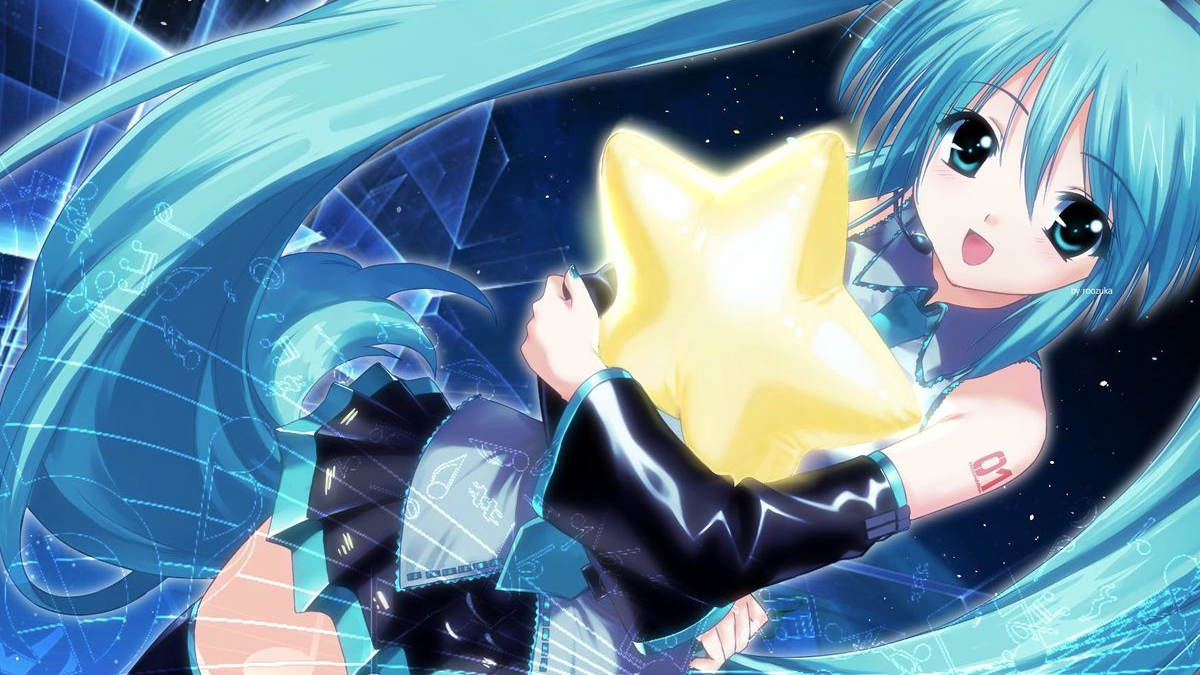
Nightcore is a music phenonmenon that spawned in the early 2000s, consisting mainly of remixed tracks. The tracks are “sped up 15% to 40% and the pitch is increased” (Lunsford, C. 2018). It has its roots in Norweigen duo by the titular name, who released an album of Trance and Eurobeat songs, “edited to be faster and with a higher pitch as a school project” (Lunsford, C. 2018).
The genre took off on the internet and became cemented in 2000s pop culture, conciding with western fascination for anime aesthetics and wider Japanese culture, the two became more associated. As writes in his article, the history of this practice “is not well documented”, but the nightcore scene “…had a degree of crossover with online anime fandom.” (Jóhannsdóttir, 2021)
(ノ◕ヮ◕)ノ*:・゚✧♫•*¨*•.¸¸♪
Hallmarks of the Genre
| High-Pitched Vocals | Anime Visuals | Dance Music |
| Pioneered by the Norwegian duo also called “Nightcore”, pitched vocals make Nightcore the genre it is. Nightcore guides instruct creators “to speed the original recording up 25%, to around 160 BPM” Jóhannsdóttir, R. (2021) | Due to it’s ties to Otaku Culture (Japanese fan subculture) and anime boom of the early 2000s, these visuals accompany the “cute” nature of the genre. | While there have been nightcore edits of non-dance and EDM music, those two genres are typically the music used. |
(ノ◕ヮ◕)ノ*:・゚✧♫•*¨*•.¸¸♪
Nightcore, Femininity and Queerness
Nightcore has a huge fanbase of women, non-binary and wider LGBTQ+. It is no surprise when combined with the pitched up vocals, it can make any voice sound more feminine. Emma Winston argues in her paper that the vocals “sound high pitched and feminine no matter the performance or gender” of the singer on the original track (Jóhannsdóttir, R., 2021). Since higher pitched voices are likely to be associated with feminity, the entire genre can be coded feminine and challenging traditional masculine ideals of music, “queering it” (Jóhannsdóttir, R., 2021).
(ノ◕ヮ◕)ノ*:・゚✧♫•*¨*•.¸¸♪
Nightcore Accelerationist Theory
Nightcore has also be described as ” uncritically accelerationist” (Winston, E., 2017), ignoring the notion of “stasis” and intertia, to go faster and faster. Simon Whybray, host of a nightcore and hyperpop internet broadcast, suggests it is the musical outcome of the human desire to ‘go faster’ (Winston, E., 2017). Due to this, sometimes the barriers between trance and pop get extremely blurred with this genre, a big resemblance to the 1990s European Happy Hardcore scene. The music is made to give that “high” and feel elevated and joyful.
(ノ◕ヮ◕)ノ*:・゚✧♫•*¨*•.¸¸♪
Online Influence + Otaku Culture
Often paired with pictures of cute anime girls doing anything, Nightcore as a subculture is littered with anime references throughout, even if the genre doesn’t make any note to the medium itself. The rise in anime culture in the 2000s, coupled with niche internet communities dedicating their love for anime, may have conflated the two in between the years. One such Japanese term that may be used to describe the feminine sounding vocals in Nightcore is “Moe”. Moe is an emotional response due to something really cute that has “occured”, or Otaku’s (Japanese Fan Subculture) intense feelings and “own affection for fictional characters, which trigger a response in them” (Henryjenkins.org, 2025). The Moe wiki describes it as “affection, adoration, devotion, and excitement felt towards characters that appear in manga, anime, video games, and other media (usually Japanese)” (Aesthetics Wiki, n.d.). These visuals coupled with the high-pitched vocals may heighten the listening experience for the viewer and make them feel this excitable energy.
In addition to this, Moe characters who are seen as innocent and cute, are likely to sound like the feminine nightcoee vocals, and may sound “generally cutesy and anime”. As an example, the anime “Lucky Star” (2007), described as an Otaku anime, has a main cast of characters considered “moe”.

References
Lunsford, C. (2018). Observing My Perception of Reality Through Nightcore. [online] Medium. Available at: https://medium.com/@calunsford/observing-my-perception-of-reality-through-nightcore-72596c16ab4a [Accessed 9 Oct. 2025].
Jóhannsdóttir, R. (2021). Nightcore, Hyperpop and LGBTQ+ Culture Lokaverkefni til BA-prófs Listaháskóli Íslands Tónsmíðadeild Haustönn 2021. [online] Available at: https://skemman.is/bitstream/1946/42354/1/Nightcore%20Hyperpop%20og%20LGBTQ%2B.pdf.
Winston, E. (2017). Nightcore and the Virtues of Virtuality. Brief Encounters, 1(1). doi:https://doi.org/10.24134/be.v1i1.20.
Henryjenkins.org. (2025). In Defense of Moe: An Interview with Patrick W. Galbraith (Part One). [online] Available at: https://henryjenkins.org/blog/2015/01/in-defense-of-moe-an-interview-with-patrick-w-galbraith-part-one.html.
Aesthetics Wiki. (n.d.). Moe. [online] Available at: https://aesthetics.fandom.com/wiki/Moe.